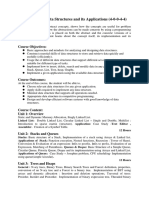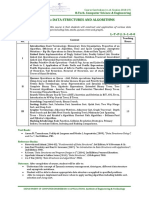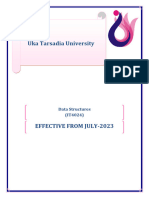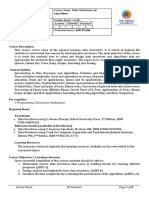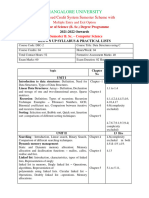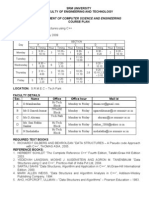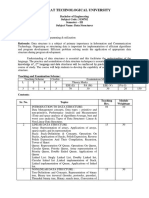CSCI2001 ELEMENTARY DATA STRUCTURES USING C++
Hours per week:4 End Examination:30Marks
Credits:4 Sessionals:70Marks
Preamble :
C++ is one of the most popular languages, contains object-orientation, Data Structures Using
C++most popular. This course helps in developing data structures and algorithms in real time
applications like arrays, stacks, queues, linked lists, trees and graphs.
Course Objective:
● To understand the linear and non linear data structures available in solving problems.
● To know about the sorting and searching techniques and its efficiencies.
● Usage of the data structures and algorithms in real time applications and ability to
design their own data structure according to the application need.
● To understand about stacks, queues, linked lists, trees and graphs.
UNIT - I
Fundamental Concepts: Introduction to Data Structures, Types of Data Structures, and
Implementation of data structures, Analysis of Algorithms.
Complexity of algorithms: Space complexity, Time complexity.
Linear Data Structure Using Arrays: Sequential Organization, Linear Data Structure.
Using Sequential Organization: Arrays, Array as an Abstract Data Type, Memory
Representation and Address Calculation, The Class Array, Inserting an element into an array,
Deleting an element, Pros and Cons of Arrays, Applications of arrays, Sparse Matrix. (7)
Learning Outcomes:
By the end of this Unit, the student will be able to
● Describe the basic concepts of Data Structures.(L2)
● Choose appropriate algorithms of Complexity.(L3)
● Use Linear array.(L3).
● Outline the Applications of arrays and Sparse Matrix.(L2)
UNIT - II
Stacks: Primitive operations, Stack Abstract Data Type, Representation of Stacks Using
Sequential Organization (Arrays), Applications of Stack, Expression Evaluation and Conversion
Polish notation and expression.
Queues: Concept of Queues, Queue as Abstract Data Type, Realization of Queues Using Arrays,
Circular Queue, Advantages of using circular queues, Array implementation of priority queue.
(12)
Learning Outcomes:
By the end of this Unit, the student will be able to
● List the difference between Stacks and Queues.(L1).
● Develop Applications of Arrays and Stacks(Polish notations).(L3).
● Apply Circular queue and advantages of using circular queues.(L3).
● Describe Array implementation of priority queue.(L2).
UNIT - III
Linked Lists: Introduction, Linked List, Comparison of sequential and linked organizations,
Linked list terminology, Primitive operations, Realization of Linked Lists using arrays, Linked
list using dynamic memory management .
Linked List Abstract Data Type: Data structure of node, Insertion of a node, Linked list
traversal, Deletion of a node, Types of linked list, Linear and Circular linked lists, Linked Stack,
Linked Queues . (10)
Learning Outcomes:
By the end of this Unit, the student will be able to
� ● Describe Linked List.(L2)
● Apply Primitive operations.(L3)
● Use Linked list using dynamic memory management.(L3)
● Outline the Circular linked list, Linked stack and Linked Queues.(L2)
UNIT - IV
Trees: Introduction, Basic terminology, Types of Trees, Binary Tree, Properties of a binary tree,
Binary Tree Abstract Data Type, Array implementation of binary trees, Linked implementation
of binary trees, Binary Tree Traversal, Conversion of General Tree to Binary Tree.
Binary Search Tree: Basic Concepts, Traversals, Creation, Insertion, Deletion of binary search
trees. (8)
Learning Outcomes:
By the end of this Unit, the student will be able to
● Explain the need of Trees.(L2)
● Describe the basic concepts Binary Search Tree.(L2)
● Use traversals, Creation, Insertion, Deletion of binary search trees.(L3)
UNIT - V
Graphs: Introduction, ADT of Graph, Representation of Graph, Graph Traversal, Spanning
Trees.
Searching: Search Techniques, Sequential Search, Binary search.
Sorting: Types of sorting, General sort concepts, Bubble sort, Insertion sort, Selection sort
Quick sort (8)
Learning Outcomes:
By the end of this Unit, the student will be able to
● Describe the Graphs.(L2)
● Explain the need of search Techniques.(L2)
● Use sorting types.(L3)
Text Book:
1. Data Structures using C++ by VarshaH.Patil, Oxford University Press, New edition, 2012.
Reference Books:
1.Fundamentals of Data Structures in C++ by Ellis Horowitz, Sartaj Sahni Anderson, Freed,
2nd edition 2008.
2. Data Structures using C++ by D.S.Malik, Cenage Learning, 2nd edition,2009.
Course Outcomes:
Upon completion of the course, the student is able to
● Describe knowledge of basic data structures of Arrays, Sequential organizations(L6)
● Develop knowledge of various operations of Stacks, Queues (L6)
● Develop knowledge of various operations Linked Lists(L6)
● Describe knowledge of various operations on Tress and Graphs(L1)
● Describe knowledge of various sorting and Searching techniques (L6)
� CSCI2011 DATA STRUCTURES USING C++ LAB
Hours per week: 2 Continuous Evaluation: 100 Marks
Credits: 1
Objective: To develop skills to design and analyze simple linear and non linear data structures
and identify the appropriate data structure for the given problem and to write and execute
programs in C++.
1. Implementation of Array Operations.
2. Implementation of Sparse Matrix Addition, Multiplications.
3. Array implementation of stack.
4. Array implementation of Queue.
5. Implementation of circular queue ADT using an array.
6. Implementation of conversion of expressions.
7. Implementation of Postfix Expression Evaluation.
8. Implementation of Singly Linked List operations, insertion, deletion, display, reverse.
9. Implementation of Linked Stack Operations.
10. Implementation of Linked Queue Operations.
11. Implementation of Binary Search Tree Creation, Traversals.
12. Implementation of Graph Traversals.
13. Implementation of Linear Search, Binary Search.
14. Implementing the following sorting methods.
a. Bubble sort
b. Insertion sort
c. Selection Sort
d. Quick sort
References Books:
1. Data Structures with C++ by John R. Hubbard, TMH, 1st edition,2004.
2. Data Structures using C& C++ by Rajesh K Shukla, Wiley Publications,2009.
3. Data Structures using C++ by Varsha H Patil, Oxford University Press, New edition,2012.
Course Outcomes:
Upon completion of the course, the student is able to
● Able to develop and implementation of Array operations.(L3)
● Examine the working of Spares Matrix Addition, Multiplications,
conversion expression (L4).
● Able to develop and implement Stack, queue, circular queue,(L3)
● Understand various linked list operations.(L2)
● List the concepts of Binary Search Tree Traversals, Graph Traversals, Linear Search,
Binary Search able develop applications. (L4)
● Understand sorting methods Bubble sort , Insertion sort, Selection sort, Quick sort.(L2)







